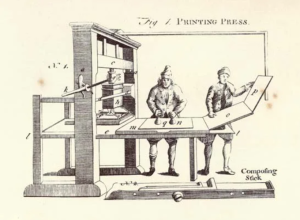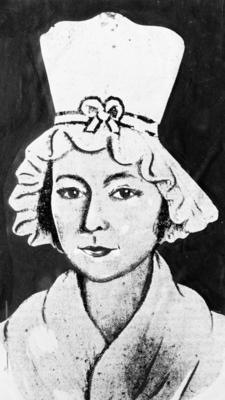Medieval (about 476AD-1600’s)
28 The First Moveable Type Printing Press
Marisa Sauls
Introduction
The printing press is a form of technology, first invented by Johannes Gutenberg, that contributed to the rapid spread of accurate information across the world. The first movable type printing press increased literacy rates an offered individuals new ways to think about themselves, the world around them and their purpose in it. While we may not think of printers today as having a major impact on society, much of the knowledge that circulates throughout the human race is shared through the printed word. Gutenberg’s dedication to innovation ultimately changed the way the world operated, altering it to the world we know today.

Connection to STS
The Printing Press was one of the most influential and life-changing forms of technology in the Medieval time period. This technology improved communication across Europe and encouraged those without an education to learn how to read and write. With efficient communication, the Printing Press allowed for the mass spread of religious texts, famous works and geographical maps and charts. In addition to the start of a societal enlightenment, the economy also prospered from the creation of this new printing technology. Without a willing society, this technology would’ve never emerged or been as popular as it was.
A Look Back in Time
In 3200 BCE, the Sumerians of Mesopotamia were the first to record business dealings on wet clay tablets using various tools to sketch shapes. These clay tablets were left out in the sun to dry; a written document (see Figure 1). Promptly after the Sumerians, the Egyptians developed a writing system that used characters that were more picture like than cuneiform. This Egyptian writing was known as “hieroglyphics.”
One important milestone in Egyptian writing was the development of papyrus as a writing surface. Papyrus is made of a plant that grows along the Nile River and it was widely used because it provided a smooth and flexible surface to write on. When pasted together, sheets of papyrus formed long rolls called scrolls. While papyrus was inexpensive to make, it wore out extremely quickly. This defeated the purpose of attempting to document important information. Parchment paper was also used, but it was expensive and time consuming to produce. Another organic material that was used to create a writing surface was raw animal hides. The downside was that it was a long and tedious process to fully clean the hides and it took several animals to make just one book (Yomtov, 2015).

Who was Johannes Gutenberg?
In the late 1430s, Johannes Gutenberg, a German inventor and craftsman, had begun work on some form of mechanical means that could reproduce texts in large quantities. Gutenberg single handedly created a printing process and a printing machine (Yomtov, 2015). Less than 50 years after Gutenberg’s creation, 236 European towns had printing presses; the printing press was spreading like wildfire. More than 35,00 editions of books had been published (Yomtov, 2015). The printing press quickly became the primary technology for communication and knowledge was able to spread efficiently across Europe in all forms. Such forms included maps, charts, diagrams, pamphlets and of course, books. The first book ever printed using the movable type press was the Forty-Two-Line Bible, which was completed no later than 1455 (Yomtov, 2015).

The Gutenberg Bible and other works
Gutenberg’s earliest work was the Donatus, which was one of the most widely used books of the 1400s. His second work was the German poem, The Sibylline Prophecies, which was about the life of Jesus Christ and the history of the church. From the sales of these two books, Gutenberg hoped to gain enough money to finance his ultimate dream project; printing the Bible
Gutenberg and the assistants he hired along the way worked 5 years to print 180 copies of the Bible. Each copy contained 1,280 pages and the text on each page was arranged into 2 columns of 42 lines each. This is why this issue of the Bible is referred to as the “Forty-Two-Line Bible.” The printing press could now produce in a month, what would have taken a scribe a lifetime to copy (Yomtov, 2015).

About The Movable Type
One of the first mechanism for printing was referred to as block printing, which was a slow and tedious process. Only one block was carved at a time and that block could be used to print only one page. A new block had to be carved by a printer for each new page, not ideal. In 1041, a Chinese blacksmith and printer, Pi Sheng created a solution to this problem: the movable type. Instead of carving large blocks, Sheng carved smaller blocks, called type, out of clay. These could then be placed together to print an entire page and taken apart and rearranged (Yomtov, 2015).
Block printing first appeared in Europe in the early 1300s. It is said that the earliest known European block prints feature religious themes. Much of of the work produced in the late Middle Ages was Christian scripture and religious texts, especially the Bible.
Missing Voices
It is important to consider the other side of history that is not advertised or openly shared as often. While any trade job during the Middle Ages and Medieval time periods were assumed to be a man’s responsibility, much of the work that women carried out goes undocumented and unnoticed. According to the journal article by Gay Walker, “women played a significant part in the history of the first 180 years of printing in America” (Walker, 1987, pg. 1). This was seen most often by widows carrying on their husbands’ print business, to make a life for themselves. Their printed works ranged from novels to sermons, from government publications to newspapers. Many of these ambitious women hired apprentices and ran well-respected shops. Others were hired to print official documents of the colony or local government, with one being appointed City Printer for Philadelphia for 20 years (Walker, 1987).

Ultimately, women have been involved in the life of printing for centuries. The first English woman printer was Elizabeth Pickering in 1539. Among the most “prolific” of the early American female printers were Jane Aitken and Lydia Bailey, both from Philadelphia. Additionally, many prints held by the Yale Libraries were produced under the direction of Hannah Watson of Hartford (Walker, 1987). Other women such as Cornelia Smith Bradford, Mary Wilkinson Crouch and Margaret Green Draper all had major impact on the printing business in America and Europe. It was due to their ambitious efforts that some of the most popular works we know and love today were printed and shared across generations. Most of these women were widows of men who were printers, and instead of falling victim to societal norms of remarrying, they chose to take matters into their own hands.
The best known Connecticut early woman printer was Hannah Watson, whom in 1771, married Ebenezer Watson, an apprentice of Thomas Green (see Figure 5). Ebenezer Watson and Thomas Green started The Connecticut Courant until the partnership dissolved and Watson carried on alone. Watson and Austin Ledyard started a paper mill shortly after. After Watson died in 1777, Hannah Watson was left with 5 children, the paper mill and a printing business. She was able to continue to business and formed a partnership with George Goodwin. Even though the paper mill eventually burned down, Hannah and her partner never missed a newspaper issue (Walker, 1987). Even after she remarried and her husband took over the printing business, she was still responsible for the shop and also printed sermons, books, pamphlets and forms. The newspaper her business printed still carries on today and is known as The Hartford Courant. Although it wasn’t Hannah that started the printing business, she was able to use her newspaper to support the American Revolution, ultimately aiding in Connecticut’s transformation from an English colony to a U.S. state (Correia).

Economic Impact
According to Jeremiah Dittmar in the journal article written on the economic impact of the printing press, the movable type printing press was the great innovation in early modern information technology. It is noted that between the years 1450 and 1500, “the price of books fell by two-thirds, transforming the ways ideas were disseminated and the conditions of intellectual work” (Dittmar, 2011, pg. 1). While the printing press fostered advancements in the spread of religion, philosophy, cultural movements, and art, it also played a key role in the development of numeracy, business education and bookkeeping/accounting. This alone was essential to tracking the economic impact the press had on the world. It is argued that the printing press was one of the most important cost reducing inventions in history.
The adoption of the printing press also impacted European city growth. Cities who adopted the technology experienced human capital accumulation and increased intercity trade. Additionally, cities who used the press had more face-to-face business interactions and higher wages that ultimately attracted more migrants to those areas. With the increasing use of the printing press, laborers and merchants developed new skills like calculating interest rates, profit shares and exchange rates. Merchants that now had the accounting skills brought on by the press could now develop cutting-edge business practices. A win-win situation.
Conclusion
While we have considered many ways in which the printing press ultimately contributed to the technological advancement and modernization of society, there are even more aspects that we may not be able to fully understand until years into the future. The Printing Press and the individuals involved in its success and development singlehandedly brought rise to intellectual thinking and increased literacy, public interaction and trade, and cultural and religious movements that changed the world for the better. While the world of printing may not be considered novel and fascinating today, the way printing emerged in society was once and still is the movement that changed the modern world for the better.
References
Correia, E. (2023, October 25). Hannah Bunce Watson: One of America’s first female publishers – connecticut history: A CT humanities project. Connecticut History | a CTHumanities Project – Stories about the people, traditions, innovations, and events that make up Connecticut’s rich history. https://connecticuthistory.org/hannah-bunce-watson-one-of-americas-first-female-publishers/
Dittmar, J. (2011). Information Technology and Economic Change: The Impact of the Printing Press. EBSCO Host. https://web-p-ebscohost-com.libproxy.clemson.edu/ehost/pdfviewer/pdfviewer?vid=0&sid=6a5fb183-b09e-47af-9d77-b110c645e50b%40redis
Walker, G. (1987). Women Printers in Early American Printing History. JSTOR. https://www.jstor.org/
Yomtov, N. (2015). How the printing press changed history. ABDO Publishing Company.
Images
Figure 1: Illustration of a printing press and a composing stick from the first edition (1768–71) of the Encyclopædia Britannica, vol. 3, plate CXLVII, figure 1. Encyclopædia Britannica, Inc.
Figure 2: “Sales Contract Shuruppak” is in the Public Domain
Figure 3: “Gutenberg” is in the Public Domain
Figure 4: Ars minor” by Aelius Donatus is in the Public Domain
Figure 5: “The Women’s Army Auxiliary Corps on the Western Front” by John Warwick Brooke is in the Public Domain
Figure 6: “Hannah B. Watson: A Pioneering Patriot” by Hartford Courant
AI Acknowledgment
AI (ChatGPT) was utilized in order to outline the skeleton of this chapter, however, was not utilized to write any wording or main ideas of the chapter.

